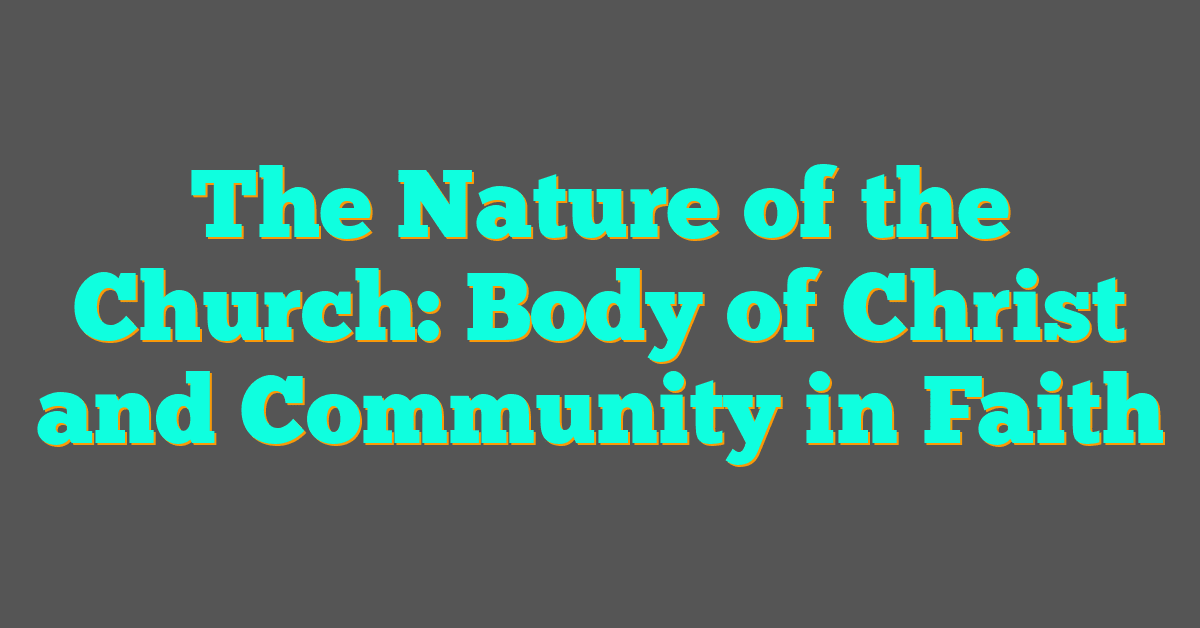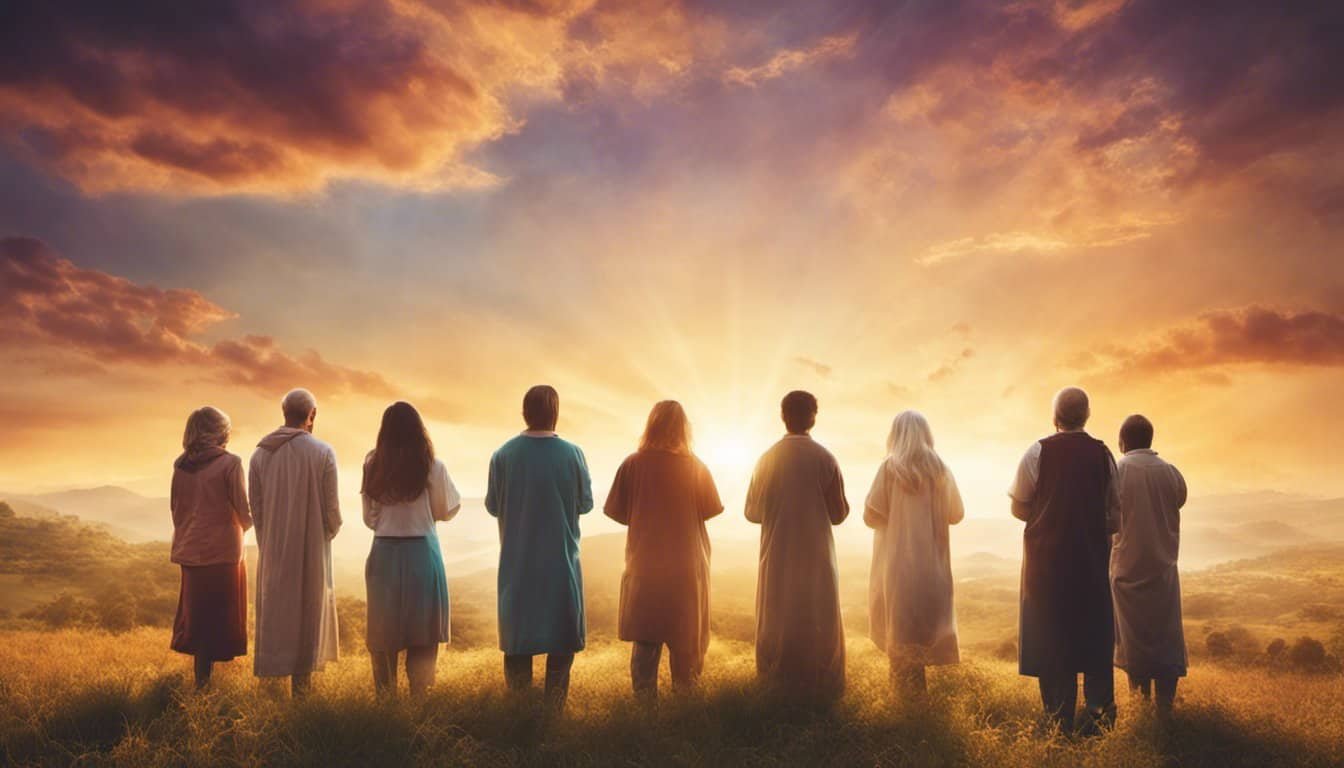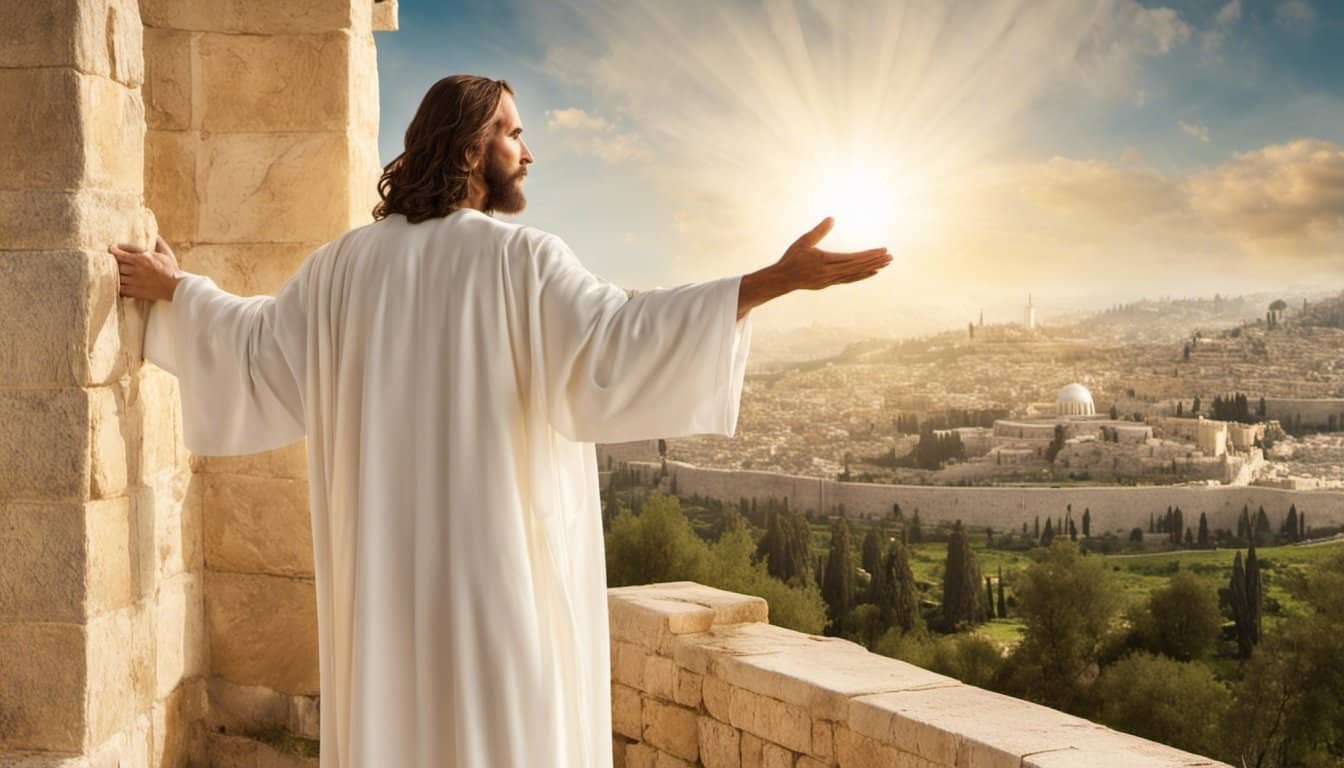The church serves as both a community and a spiritual body. At its core, the church is described as the Body of Christ, where members work together to fulfill a shared mission. This metaphor highlights the interconnectedness of believers, illustrating how each person’s unique gifts contribute to the community’s overall purpose.


Understanding the nature of the church involves exploring its biblical foundations and theological perspectives. It is not just about gathering in a building; it is about forming relationships, engaging in worship, and serving others.
The church provides a space for individuals to grow both personally and collectively as they deepen their faith and strengthen their bonds with one another.

As this article unfolds, it will delve into the many aspects of the church, examining its unity and diversity while addressing the challenges it faces. Readers will discover how the church continues to adapt and evolve, ensuring that it serves as a relevant force in today’s world.
Key Takeaways
- The church is described as the Body of Christ, emphasizing teamwork in faith.
- It fosters personal and collective growth while encouraging service and mission.
- The church faces challenges and reforms but remains relevant in modern society.
The Biblical Foundation of the Church
The Church is built on a rich biblical foundation that is woven throughout the New Testament. This foundation includes key references to Jesus Christ, the teachings of early Christians, and metaphors that describe the Church’s role and significance.
The Church in the New Testament
The New Testament emphasizes that the Church is the body of Christ. In several letters, the Apostle Paul explains this concept, asserting that believers are united in faith through Jesus. For instance, in Ephesians 1:22-23, Paul declares, “And God placed all things under his feet and appointed him to be head over everything for the church.”
The Gospels also highlight the importance of community. Jesus established His followers as a new covenant people, calling them to love and support one another. His teachings thank and empower believers with the Gospel message, encouraging a deep commitment to each other and their shared mission.
Metaphors of the Church
Various metaphors throughout the New Testament help convey the nature of the Church. One major metaphor is the body of Christ. As noted in Romans 12:4-5, Paul writes, “For just as each of us has one body with many members, and these members do not all have the same function, so in Christ we, though many, form one body.”
This metaphor shows that each believer has a unique role to play. Another metaphor found in Galatians is that of family. Believers are referred to as children of God, indicating a deep, supportive relationship among them.
Early Christian Community
Early Christians practiced their faith within close-knit communities. These communities were marked by shared beliefs, prayer, worship, and the breaking of bread. Acts 2:42 describes this experience, stating, “They devoted themselves to the apostles’ teaching and to fellowship, to the breaking of bread and to prayer.”
They supported one another in both spiritual and practical ways. Love and generosity were key aspects of their lives. This sense of community helped the Church grow, as they lived out the teachings of Jesus Christ and spread the Gospel message to others.
Theological Perspectives on the Church

The church holds a special place in Christian theology. It is seen as both the Body of Christ and a community of believers. This section explores key ideas about the church, its members, and their shared mission.
Body of Christ Explained
The church is often referred to as the “Body of Christ.” This concept signifies that believers are united under Christ, who is the head. Each member has a unique role, contributing to the body’s overall function.
Key Points:
- Unity in Diversity: Every believer brings different gifts, talents, and perspectives. This diversity strengthens the church’s mission.
- Spiritual Connection: Believers share a spiritual bond through grace and salvation. They experience Christ’s presence together in prayer and worship.
The Body of Christ emphasizes that individuals are not alone in their faith journey. They are part of something larger and profoundly significant.
Community and Fellowship
Community and fellowship are vital aspects of the church experience. Christians gather to support one another, helping to grow in faith together.
Essential Aspects:
- Mutual Support: Members provide emotional and spiritual support. This strengthens relationships and encourages personal growth.
- Shared Worship: Through communal worship, believers experience the presence of Christ in a deeper way.
Fellowship nurtures connections and deepens understanding of Scripture. These interactions help believers reflect Jesus’s love and teachings in everyday life.
The Church as the Bride of Christ
The church is also called the “Bride of Christ.” This metaphor reflects a deep, covenantal relationship between Christ and the believers.
Significant Ideas:
- Covenant Relationship: Just as a bride and groom commit to each other, the church commits to Christ, who offers love and salvation.
- Anticipation of Christ’s Return: The idea of the church as a bride suggests a waiting period for Christ’s return. This encourages faithfulness and hope.
This imagery captures the essence of devotion and love in the church. It highlights the relationship believers have with Christ, marked by grace and commitment.
Unity and Diversity in the Church

In the church, unity and diversity work together to strengthen the community of believers. By celebrating different backgrounds and perspectives, the church reflects the fullness of God’s creation while maintaining a shared faith.
The Church as One Body
The church is often described as one body made up of many parts. This analogy highlights the interconnectedness of all believers. Each member plays a unique role, contributing to the health of the whole community.
For example, some may serve as teachers, while others may provide support through administration or hospitality. In this way, every believer’s gifts are essential for the growth and well-being of the church.
By working together in unity, they represent Christ’s love and mission in the world, showcasing true harmony in diversity.
Jews and Gentiles United

The early church faced challenges as Jews and Gentiles came together in faith. Traditionally, these groups had different customs and beliefs. The call for unity transformed their relationship into one of acceptance and shared purpose.
In Galatians 3:28, it is stated, “There is neither Jew nor Gentile, neither slave nor free, nor is there male and female, for you are all one in Christ Jesus.” This emphasizes the breaking down of barriers that once divided them.
As a result, local churches became vibrant communities where differences were celebrated. This unity not only honored God but also strengthened the witness of the church to the wider world.
The Role of Diversity
Diversity in the church enriches the community experience. Each believer shares unique experiences, cultures, and perspectives. This variety brings depth to worship and community life.
When congregations embrace different backgrounds, they can learn from one another. For example, cultural expressions through music, art, and traditions enhance communal worship.

Furthermore, it fosters empathy and understanding. As believers grow together in faith, they learn to appreciate what each person brings to the table, creating a fuller picture of God’s goodness.
Unity thrives when diversity is welcomed and integrated into the life of the church.
Sacraments and Worship
Sacraments play an essential role in the worship and life of the church. They connect the faithful to God and build a sense of community. This section explores key sacraments, particularly baptism and communion, and how they enhance worship experiences.
Baptism and Communion
Baptism is a significant sacrament that marks the entry of believers into the Christian community. It symbolizes a person’s faith in Christ, representing the death of the old self and the new life in the Holy Spirit. During baptism, individuals publicly affirm their commitment to follow Jesus.

Communion, also known as the Eucharist, is another vital sacrament. It involves sharing bread and wine, representing the body and blood of Christ. This act is a reminder of Jesus’ sacrifice and fosters unity among believers. By participating in communion, the faithful strengthen their bond with Christ and with one another.
Living the Sacraments
Living the sacraments goes beyond the rituals themselves; it reflects a lifestyle of faith. The faithful are encouraged to incorporate the values of baptism and communion into daily life. This means showing love, kindness, and compassion to others.
The influence of the Holy Spirit guides individuals to live out their faith actively. Practicing the teachings of Christ helps believers stay connected to their community and grow spiritually. These acts of service and fellowship are expressions of the grace received through the sacraments.
Divine Worship in the Church
Divine worship encompasses more than just the sacraments; it is about experiencing God’s presence in the church. Worship services offer opportunities for prayer, singing, and teachings that inspire and uplift the faithful.
During these gatherings, believers come together, creating a strong sense of community. The church serves as a place where individuals deepen their faith, supported by one another. Through collective worship, they recognize the importance of the sacraments like baptism and communion as integral parts of their spiritual journey.
The Practical Life of the Church

The practical life of the church involves how its members serve, connect, and lead in their communities. This section looks at the importance of spiritual gifts, the differences between local and universal churches, and the roles of governance and leadership.
Spiritual Gifts and Roles
Every Christian has unique spiritual gifts given by the Holy Spirit. These gifts include teaching, serving, encouraging, giving, and leadership. Each role plays a crucial part in the church’s mission.
For example, teachers help others understand scripture, while servants meet physical needs within the community. This diversity strengthens the church and serves its members effectively.
Understanding one’s gifts is important for fulfilling a specific role in the church. By using these gifts, members contribute to the church’s divine life and growth.
Local Church vs. Universal Church

The local church refers to a specific congregation where members gather for worship and fellowship. In contrast, the universal church represents all Christians worldwide.
Each local church plays a vital role in the broader community. Local churches support believers through worship services, Bible studies, and community outreach.
The universal church emphasizes unity among all believers. Nothing can replace the local experience of worship, yet the connection to the global body is essential for Christians to feel part of a larger mission.
Church Governance and Leadership
Church governance outlines how decisions are made and leadership is structured. Common structures include pastors, bishops, and committees.
Pastors, often considered shepherds, guide the congregation and provide spiritual direction. The college of bishops can offer oversight and ensure that teachings align with core beliefs.

Leadership is meant to serve the members and encourage growth in faith. Clear governance helps maintain order and accountability, allowing the church to effectively minister to its members and community.
Mission and Service
The church plays a vital role in mission and service. It actively seeks to spread love, compassion, and the message of Christ in the world.
Through various acts of service, members of the church embody the values of the Kingdom of God and work toward harmony both locally and globally.
Church’s Mission in the World
The church’s mission involves sharing the message of Jesus Christ with people everywhere. This mission is rooted in the call to help heal the brokenness in the world.

By promoting values like love, peace, and justice, the church strives to be a light in dark places. This includes engaging in community outreach and missionary work, especially in areas where hope is needed.
Acts of Service and Compassion
Acts of service are expressions of faith that reflect Christ’s love. They often focus on helping the needy, such as providing food, shelter, and medical care.
Churches organize food drives, offer counseling, and support local shelters. Each action is a way to demonstrate compassion and embody the fullness of Christ. These acts of service help build a community of saints who support one another and share joy and encouragement with each other.
International and Ecumenical Relations
The church also recognizes the importance of working with other Christian communities. By engaging in international and ecumenical relations, it promotes visible unity among believers.
This collaboration allows diverse communities to come together, sharing resources and wisdom. The church’s mission isn’t limited to local outreach; it extends to global partnerships, creating a united front to address issues like poverty and injustice. The hope is for a new Jerusalem where all can thrive in harmony, reflecting the teachings of Jesus Christ.
Personal and Collective Growth
Personal and collective growth within the church fosters a strong community where faith flourishes. By focusing on faith and conversion, community building, and the church’s role in personal development, individuals can deepen their relationship with God and one another.
Faith and Conversion
Faith is the cornerstone of personal growth. It begins with conversion, where individuals experience a change of heart and a commitment to follow Christ.
This transformation often leads to a profound sense of belonging in the household of God.
Through faith in Christ, believers receive graces that strengthen their spiritual journey. They experience redemption and reconciliation, which help them overcome personal struggles.
This newfound faith encourages others to seek the same relationship with God, creating a ripple effect within the community.
Community Building
Building a community is essential for nurturing faith. The church serves as a community of the saints, offering support and encouragement.
Group worship, prayer, and study enhance connections among members. Sharing experiences fosters a sense of love and unity.
When individuals gather in fellowship, they help each other grow. Through Bible study and group discussions, people deepen their understanding of their faith. They learn to love God and one another, creating a welcoming environment for those exploring faith.
The Church’s Role in Personal Development
The church plays a vital role in personal development. It provides a space for believers to seek guidance and mentorship.
Pastors and church leaders offer support and share biblical teachings that aid in personal growth.
Additionally, the church encourages participation in service and missions. Serving others cultivates humility and compassion. Acts of love within the community demonstrate faith in action, reinforcing the idea that growth occurs both individually and collectively. Through these efforts, a thriving and infallible church emerges, uniting the community in faith and purpose.
Challenges and Reforms
The church faces several challenges that impact its role as the body of Christ and community. These include cultural shifts, issues of unity, and the need for reformation. Each of these factors plays a significant role in how the church operates today.
Cultural Impacts on the Church
Cultural changes can influence how the church functions. Many congregations find it difficult to connect with younger generations. This disconnect often results from differing values and beliefs.
To address this, churches may need to adapt their messages and practices. This doesn’t mean changing core beliefs but rather finding new ways to communicate them.
Engaging activities, modern music, and open discussions can help bridge gaps.
Additionally, the rise of technology offers unique opportunities. Online services and social media can extend the church’s reach. Yet, challenges arise when balancing tradition with contemporary culture.
Unity of the Church vs. Sectarianism
The call for unity within the church is powerful. It is essential for reflecting Christ’s body, yet many face sectarian divides. Different interpretations of scripture can lead to fragmentation.
This sectarianism often causes conflicts between denominations, such as the Catholic Church and local bodies. Each group may focus on its beliefs rather than shared faith. Such divides can weaken the Christian message to the wider community.
Promoting dialogue and understanding can encourage unity. Collaborative events between different congregations foster cooperation. This unity is not just desirable; it is a reflection of Christ’s love and mission.
Reformation and Revival
Reformation has often been necessary for the church throughout history. It is the process of addressing issues that hinder spiritual growth. Examples may include a lack of engagement or outdated practices.
Revival seeks to restore passion and commitment among believers. Effective reforms can breathe new life into a struggling church. They might involve educational programs, community outreach, or revitalized worship styles.
Listening to congregational needs is key. When churches respond to their members, they create a stronger, more involved community. Reformation and revival together can lead to a healthier church aligned with its mission.
Future Outlook
The future of the church holds significant promise. It is shaped by its role in modern society, the influence of prophetic voices, and the empowerment of the next generation. All these factors will play a part in how the church continues to embody the Body of Christ and serve as a community.
The Church in Modern Society
In today’s world, the church faces unique challenges and opportunities. As society evolves, it becomes essential for the church to adapt while holding onto its core values.
Key aspects to consider include:
- Inclusivity: The church is called to be an ekklesia that welcomes diverse backgrounds.
- Cultural Relevance: Engaging with contemporary issues like social justice and mental health keeps the church relevant to younger members.
- Connection and Community: Creating spaces for connection promotes strong church membership.
These elements can help the church thrive as it fulfills its role in the kingdom of heaven.
Prophetic Voices and Visions
Prophetic voices play a crucial role in directing the future of the church. These individuals share insights and visions that help guide communities.
- Vision Casting: Leaders often use prophetic insights to create a roadmap for the church’s future.
- Encouragement to the Congregation: These messages inspire the church to embrace its new covenant identity as messianic people.
- Building Faith and Hope: Prophetic voices remind believers of God’s promise.
By listening to these voices, the church can be a beacon of hope and action.
Empowering the Next Generation
The next generation is vital for the church’s future. Empowering young people ensures the continuity of faith and community.
- Education and Mentorship: Providing robust educational programs helps youth grow spiritually.
- Active Participation: Involving them in church activities fosters leadership skills.
- Fulfilling the New Commandment: Teaching young people to love one another strengthens community bonds.
Supporting the next generation helps the church remain vibrant and impactful, living its role as the temple of God.















